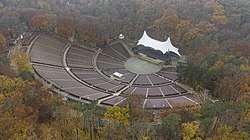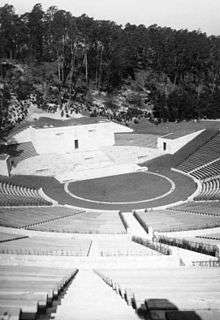Waldbühne
The Waldbühne (Woodland Stage or Forest Stage) is an amphitheatre at Olympiapark Berlin in Berlin, Germany. It was designed by German architect Werner March in emulation of a Greek theatre and built between 1934 and 1936 as the Dietrich-Eckart-Freilichtbühne (Dietrich Eckart Open Air Theater), a Nazi Thingplatz, and opened in association with the 1936 Summer Olympics. Since World War II it has been used for a variety of events, including boxing matches, film showings and classical and rock concerts. It seats more than 22,000 people. The venue is located off Friedrich-Friesen-Allee just northeast of Glockenturmstraße.
 Aerial view (2019) | |

| |
| Former names | Dietrich-Eckart-Freilichtbühne (1936–48) |
|---|---|
| Address | Glockenturmstraße 1 14053 Berlin Germany |
| Location | Olympiapark Berlin |
| Coordinates | 52°30′57″N 13°13′44″E |
| Owner | Senate of Berlin |
| Operator | CTS Eventim |
| Type | Amphitheatre |
| Capacity | 22,290 |
| Construction | |
| Built | 1934–36 |
| Opened | 2 August 1936 |
| Renovated | 1969, 1982 |
| Website | |
| Venue website (in German) | |
Nazi era

The theatre was built as part of the Olympic complex on the request of Propaganda Minister Joseph Goebbels.[1] March made use of a natural ravine and modelled the theatre on ancient Greek amphitheatres.[2][3] With the intent of showing the kinship between ancient Greek and Germanic culture, the entrance is flanked by two pairs of reliefs by Adolf Wamper: on the left, representing the "Fatherland", two male nudes, one with a sword, the other with a spear,[2][4] a pairing that was to be used more famously by Arno Breker;[5] and on the right, representing artistic celebration, two female nudes, one with a laurel wreath, the other with a lyre.[6][7] The arena, the Maifeld field, and the Olympic stadium itself were designed to be used together for large events, and March also provided an indoor arena in the nearby Haus des deutschen Sports (House of German Sports) that has been regarded as a smaller equivalent of the Dietrich Eckart theatre.[8]
The theatre opened on 2 August 1936, the day after the opening of the games, with the première of Eberhard Wolfgang Möller's Frankenburger Würfelspiel.[9] 20,000 people were in attendance, and the Reich Labour Service supplied 1,200 extras.[10] It was also used for some events of the games, in particular boxing matches.[11] During the Olympics and later, dance and choral movement productions took place there, in addition to operas: during the Olympics and again in 1937 for the celebration of the 700th anniversary of the founding of Berlin, Handel's Hercules; also in 1937, Gluck's Orfeo;[8] and in 1939, a production of Wagner's Rienzi paid for and co-designed by Hitler in association with Benno von Arent.[12]
Post-war
After World War II, the Olympic grounds were within the British occupation sector of Berlin. They were released for public use beginning in 1948,[11][13] and the amphitheatre was used for film showings, including for the Berlinale,[14] and beginning in 1960 for boxing matches. Use for concerts began in the 1960s,[13] but when The Rolling Stones performed there on 15 September 1965, the theatre was severely damaged. Fans stormed the stage, and after the band left after a set of only 20 to 25 minutes, fought police, who attempted to control them with rubber truncheons and fire hoses, and destroyed the seating, fire hydrants and other furnishings. 270,000 DM in damage was done, in a riot that fulfilled the dire prophecies of some Berlin newspapers about rock concerts and was the first inter-generational battle of the 1960s in Germany.[15][16][17] A reporter from Bild wrote of the concert, "I know Hell."[18] The arena had to be completely renovated[13][19] and was then little used until 1978.[13][14][20]
Jimi Hendrix second-to-last appearance in "Berlin Super Concert70" was planned at the Waldbühne on 4 September 1970. Due to bad weather conditions, it was relocated to the Deutschlandhalle. Alongside were also Ten Years After and Procol Harum. In the reality series Pawn Stars, Rick Harrison bought a rare poster for this concert for $4,000 (episode #20 of season 5, aired 30 January 2012).
Following a concert by Bob Marley in 1980, it became well known as a rock venue, and has been regularly used for that purpose since.[11][13] Some other artists who have appeared there include Queen, U2, David Bowie, Rod Stewart, The Rolling Stones, Iron Maiden, AC/DC, Berlin's Rammstein in 2016, Germany's Alphaville in 1986, Bon Jovi, Metallica, Van Halen, Black Sabbath, Pearl Jam, Kings of Leon, Radiohead, Nick Cave & The Bad Seeds, Prince, Depeche Mode, Whitney Houston and Barbra Streisand.
Phil Collins, in the British Sector of West Berlin during the last months of East Germany's existence, performed at the Waldbühne on 14–15 July 1990, during his Seriously, Live! World Tour.
The Berlin Philharmonic holds its outdoor concert there every summer, featuring noted guest artists. This concert has been broadcast on live TV since 1992.
The facility seats more than 22,000,[21] in three ranks that rise 30 metres (98 ft);[13] the last row of seats, the 88th, is also 93.5 metres (307 ft) from the centre of the orchestra pit, so originally 40 microphones were installed on-stage, feeding 10 coordinated groups of loudspeakers.[3] In 1982, a canopy costing 200,000 € was erected over the stage, providing both a visual and an acoustic barrier.[13] Concert promoter Peter Schwenkow leased it from 1981 until the end of 2008, when the lease was transferred to CTS Eventim.[13][22]
Before COVID-19, American-Armenian rock and roll band System of a Down was set to perform at the arena on 8 June 2020,[23] American singer-songwriter Taylor Swift was set to perform on 24 June 2020 as part of Lover Fest and Canadian singer Celine Dion was due to return to the arena after 11 years with the Courage World Tour[24] on 22 July 2020.
See also
- List of contemporary amphitheaters
References
- Thomas Schmidt, Werner March: Architekt des Olympia-Stadions, 1894–1976, Basel/Berlin: Birkhäuser, 1992, ISBN 978-3764324551, p. 60 (in German)
- Paul Ortwin Rave and Hinnerk Scheper, eds., rev. Irmgard Wirth, Die Bauwerke und Kunstdenkmäler von Berlin: Stadt und Bezirk Charlottenburg, Volume 1 Text, Berlin: Mann, 1961, OCLC 769067221, p. 231 (in German)
- Glen Gadberry, "The Thingspiel and Das Frankenberger Wurfelspiel", The Drama Review 24.1, March 1980, pp. 103–14, p. 106.
- Antike und Altertumswissenschaft in der Zeit von Faschismus und Nationalsozialismus, University of Zurich colloquium, 14–17 October 1998, ed. Beat Näf with Tim Kammasch, Texts and studies in the history of humanities 1, Mandelbachtal/Cambridge: Edition Cicero, 2001, ISBN 978-3934285460, p. 260 (in German)
- Klaus Wolbert, Die Nackten und die Toten des "Dritten Reiches": Folgen einer politischen Plastik des deutschen Faschismus, Kunstwissenschaftliche Untersuchungen des Ulmer Vereins, Verband für Kunst- und Kulturwissenschaften 12, Gießen: Anabas, 1982, ISBN 978-3870380953, p. 212 (in German)
- Georg Dehio, Handbuch der deutschen Kunstdenkmäler: Berlin, 3rd ed. rev. Sibylle Badstübner-Gröger and Michael Bollé, Munich: Deutscher Kunstverlag, 2006, ISBN 978-3422031111, p. 229 (in German)
- Photograph, Werner Rittich, Architektur und Bauplastik der Gegenwart, (2nd ed.) Berlin: Rembrandt, 1938, OCLC 490115936 (in German), pp. 56, 58, 59. Photograph of the arena, p. 57.
- Rainer Stommer, Die inszenierte Volksgemeinschaft: die "Thing-Bewegung" im Dritten Reich, Marburg: Jonas, 1985, ISBN 978-3922561316, p. 207 (in German)
- Glen W. Gadberry, "Eberhard Wolfgang Möller's Thingspiel Das Frankenburger Würfelspiel", in Henning Eichberg, Michael Dultz, Glen Gadberry, and Günther Rühle, Massenspiele: NS-Thingspiel, Arbeiterweihespiel und olympisches Zeremoniell, Problemata 58, Stuttgart-Bad Cannstatt: Frommann-Holzboog, 1977, ISBN 978-3772806674, pp. 235–48 [235–36].
- Karl-Heinz Schoeps, Literature and Film in the Third Reich, tr. Kathleen M. Dell'Orto, Studies in German literature, linguistics, and culture, Rochester, New York / Woodbridge, Suffolk: Camden House/Boydell & Brewer, 2004, ISBN 978-1571132529, p. 157.
- "Berliner Waldbühne", TV Berlin, 30 May 2011 (in German)
- Frederic Spotts, Hitler and the Power of Aesthetics, Woodstock: Overlook, 2002, ISBN 978-1585673452, p. 238.
- Waldbühne, Sehenswürdigkeiten, Berlin.de (in German)
- "Die Waldbühne: Amphitheater der Stars", Der Tagesspiegel, 26 March 2011 (in German)
- Detlef Siegfried, Time is on my side: Konsum und Politik in der westdeutschen Jugendkultur der 60er Jahre, Hamburger Beiträge zur Sozial- und Zeitgeschichte 41, Göttingen: Wallstein, 2006, ISBN 978-3835300736, p. 251 (in German)
- Heather Miller, The Rolling Stones: The Greatest Rock Band, Rebels of Rock, Berkeley Heights, New Jersey: Enslow, 2011, ISBN 978-1598452099, n.p.
- Christoph Klotter and Niels Beckenbach, Romantik und Gewalt: Jugendbewegungen im 19., 20. und 21. Jahrhundert, Wiesbaden: VS Verlag für Sozialwissenschaften / Springer Fachmedien Wiesbaden, 2012, ISBN 978-3531934570, p. 260 (in German) assess the property damage at almost half a million DM, but include damage to S-Bahn carriages.
- Quoted in Benjamin Maack, "Legendäres Stones-Konzert: 'Vier Stunden hat die Schlacht getobt'", Einestages, Der Spiegel, 15 July 2012 (in German); Maack notes that Ralf Reinders, later a member of the Movement 2 June anarchist group, was one of numerous fans who pushed their way in without paying and in some cases came looking for trouble.
- H. Bruns, "Poker um die Waldbühne. Wer betreibt die schönste Konzert-Location Europas? Kandidaten zögern wegen der hohen Miete", Bild, 28 July 2008 (in German)
- "1965: Rolling Stones in der Berliner Waldbühne", 60 Jahre der Bundesrepublik Deutschland, Bild, 14 April 2009 (in German), assessing the damages at 300,000 €.
- According to Bild, "Poker um die Waldbühne", 22,120.
- "Veranstalter: CTS Eventim übernimmt Berliner Waldbühne", Der Tagesspiegel, 9 September 2008 (in German)
- https://www.systemofadown.com/tour/
- https://www.celinedion.com/in-concert/
External links
| Wikimedia Commons has media related to Waldbühne, Berlin. |
- Geoff Walden, Dietrich-Eckart-Bühne, Third Reich in Ruins: then and now photographs
- Gunnar Schupelius, "The Secret Behind the Stage. Berlin's Enchanting Waldbühne Amphitheater", The Atlantic Times, May 2006.
- Pascale Hugues, tr. Elisabeth Thielicke, "Mon Berlin: Umhüllt vom Wald, bebend wie eine frisch Verliebte", Meinung, Der Tagesspiegel, 26 August 2011 (in German)
_pictogram.svg.png)